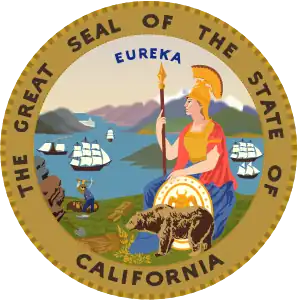Rancho La Sierra
Rancho La Sierra (also called "La Sierra de Santa Ana") was a 17,774-acre (71.93 km2) Mexican land grant in present-day Riverside County, California, United States. In 1846 Governor Pio Pico issued the grant to Vicenta Sepulveda.[1] The rancho includes the present-day city of Norco, and the western end of Riverside.[2][3]
History
Maria Vicenta Sepulveda (1816–1907)[4] was a daughter of Francisco Sepulveda, recipient of the Rancho San Vicente y Santa Monica land grant. Vicenta married Tomas Antonio Yorba (1788–1845) in 1834. Tomas was a son of José Antonio Yorba, the grantee of Rancho Santiago de Santa Ana in present-day Orange County. Tomas, along with some of his brothers, pastured animals on lands east of their father's Rancho Santiago de Santa Ana, and in 1834 his brother Bernardo Yorba requested, and was granted, Rancho Cañón de Santa Ana. Tomas and Bernardo continued to pasture lands even further east, in an area they had named La Sierra.[5]
In 1845, after Tomas had died, Bernardo applied for four square leagues of the La Sierra lands. Nine days later Vicenta Sepulveda, then a widow and going by her maiden name, also applied for some of the same La Sierra lands. On June 15, 1846 Governor Pio Pico granted the east half of the lands, Rancho La Sierra (Sepulveda), to Vicente Sepulveda, and the west half, Rancho La Sierra (Yorba) to Bernado Yorba.[5] Vicenta married Jose Ramon Carrillo (1821–1864) in 1847.
With the cession of California to the United States following the Mexican-American War, the 1848 Treaty of Guadalupe Hidalgo provided that the land grants would be honored. As required by the Land Act of 1851, a claim for Rancho La Sierra was filed with the Public Land Commission in 1852,[6][7] and the grant was patented to Vicenta Sepulveda in 1877.[8]
In 1858, Vicenta Sepulveda de Carrillo bought Rancho Valle de San Jose.
Abel Stearns purchased Rancho La Sierra, but was forced to sell after the drought of 1863. The rancho passed through several owners including the San Jacinto Land Company. It was purchased by James W. Long in 1908. Long formed the Orange Heights Water Company and began developing the area in 1910.
Through several acquisitions Willitts J. Hole (1858–1936), a Los Angeles businessman, purchased much of the original Rancho, eventually owning more than 17,000 acres (69 km2).[9] Hole continued to use the land as a ranch, which became known as the Hole Ranch, and he built a large mansion on the property. He later began subdividing the property for various developments. In 1922, he sold 400 acres (2 km2) of the land to the Seventh-day Adventist Church. In 1942, the U.S. Army purchased 1,239 acres (5 km2) of the ranch from the Hole estate, and set up Camp Anza, a World War II disembarkation facility.[10]
The North Corona Land Company bought some of the property 1921 after it was established as a subdivision of the Corona Land Company for citrus growing. The name Norco is an abbreviation of the North Corona portion of the company name. Norco was incorporated as a city in December 1964.[11] Also in 1964 the city of Riverside annexed the rest of the original Rancho La Sierra lands.[9]
Etymology
Translated from Spanish into English "La Sierra de Santa Ana" means "The mountains of Santa Ana". According to Bernardo's petition for the La Sierra lands, the Yorba brothers had used this name as early as 1825. The name distinguished the higher elevation La Sierra de Santa Ana lands from Bernardo's Cañón de Santa Ana lands, both positioned beside the Santa Ana River.[12]
Western Riverside continues to be referred to as La Sierra, with four separate city neighborhoods beginning with the name.[13] After the Seventh-day Adventist Church purchased a large section of the land they opened the La Sierra Academy, today known as La Sierra University.[14]
Historic sites of the Rancho
- Hole Mansion. Arthur Benton designed the rustic bungalow, built on the site between 1912 and 1915 for Willits J. Hole.[15]
References
- Ogden Hoffman, 1862, Reports of Land Cases Determined in the United States District Court for the Northern District of California, Numa Hubert, San Francisco
- Diseño del Rancho La Sierra
- Rand McNally map
- Vicenta Sepulveda Yorba
- Lech, pp. 46–47.
- United States. District Court (California : Southern District) Land Case 362 SD
- Finding Aid to the Documents Pertaining to the Adjudication of Private Land Claims in California, circa 1852-1892
- Report of the Surveyor General 1844–1886 Archived 2013-03-20 at the Wayback Machine
- Klotz, pp. 228–230.
- Camp Anza/Arlanza, City of Riverside
- Hoover, Mildred B.; Rensch, Hero; Rensch, Ethel; Abeloe, William N. (1966). Historic Spots in California. Stanford University Press. ISBN 978-0-8047-4482-9.
- Gunther, pp. 266–277.
- City of Riverside, Development Department, Housing and Neighborhoods, Neighborhoods Map. Retrieved 2010-07-10.
- Hole, Rindge, Williamson Scholarship
- #44 Hole Mansion Landmarks of the City of Riverside
Bibliography
- Gunther, Jane Davies. Riverside County, California, Place Names; Their Origins and Their Stories, Jane Davies Gunther, 1984. LOC Catalog Number 84-72920.
- Klotz, Esther H. and Joan H. Hall. Adobes, Bungalows, and Mansions of Riverside, California, Revisited, Joan H. Hall, 2005. ISBN 0-9631618-6-5.
- Lech, Steve (2004). Along the Old Roads: A History of the Portion of Southern California that became Riverside County: 1772–1893. Riverside, CA: Steve Lech. OCLC 56035822.
